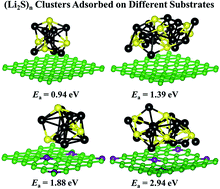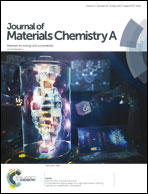Understanding the role of lithium sulfide clusters in lithium–sulfur batteries†
Abstract
Lithium sulfide (Li2S) as an electrode material not only has high capacity but also overcomes many problems caused by pure sulfur electrodes. In particular, the battery performance of nanoscale (Li2S)n clusters is much better than that of bulk sized Li2S. However, the structures, stability, and properties of (Li2S)n clusters, which are very important to improve the performance of Li–S batteries, are still unexplored. Herein, the most stable structures of (Li2S)n (n = 1–10) are reliably determined using the advanced swarm-intelligence structure prediction method. The (Li2S)n (n ≥ 4) clusters exhibit intriguing cage-like structures, which are favorable for eliminating dangling bonds and enhancing structural stability. Compared to the Li2S monomer, each sulfur atom in the clusters is coordinated with more lithium atoms, thus lengthening the Li–S bond length and decreasing the Li–S bond activation energy. Notably, the adsorption energy gradually increases on the considered anchoring materials (AMs) as the cluster size increases. Moreover, B-doped graphene is a good AM in comparison with graphene or N-doped graphene. The predicted characteristic peaks of infrared, Raman, and electronic absorption spectra provide useful information for in situ experimental investigation. Our work represents a significant step towards understanding (Li2S)n clusters and improving the performance of Li–S batteries.



 Please wait while we load your content...
Please wait while we load your content...